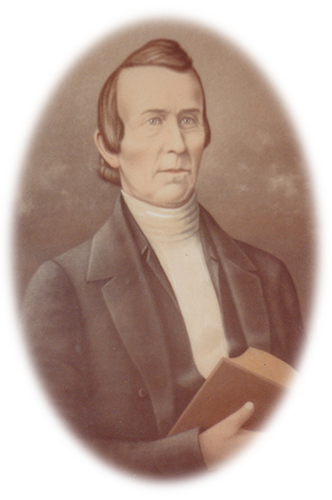
Yesterday (March 25th) was an important day in CGGC history. I know a few of you noted the importance of the day as I saw some of your social media feeds. John Winebrenner, the founder of the Churches of God, General Conference, was born on March 25, 1797 in Frederick County, MD.
We’re all born into a time and place in history. Winebrenner was born into an exciting time of change, growth and expansion in the United States. Our country was barely 20 years into the great experiment that we continue to steward and enjoy. He was born into the Second Great Awakening and his ministry would be shaped by the revivalist fires of that time.
Winebrenner began his ministry with the German Reformed Church (today known as the United Church of Christ) in October 1820 in Harrisburg, PA. It didn’t take Winebrenner long to run into trouble with his own church council (known as the Vestry in those days). There was a long list of complaints against the young pastor: he acted independent of the church council, he was preaching at Methodist churches and bringing in visiting ministers from other denominations, he held anxious meetings that we noisy and filled with groaning, lots of praying and outbursts of others responding with loud responses of Amen, prayer meetings and services could run until 4 a.m. and he wasn’t visiting the sick members of the congregation enough.
Many were uncomfortable with what they saw as Winebrenner’s extreme revivalistic methods known as “new measures” in those days. Having women pray in gatherings where men were present, praying for a person by name in a public meeting, holding meetings into the late hours of the night or holding protracted meetings that might continue for days or weeks or the use of anxious meetings focused upon the salvation of souls were all part of the “new measures” that Winebrenner embraced much to the chagrin of some in his congregation. His conviction that many of the faithful church members were in fact, not born again or living without Christ didn’t make him popular in his own congregation.
I often wonder how John Winebrenner would be received today in many of our congregations? My guess is that he would make a lot of us just as uncomfortable as he did some of his contemporary peers. His “new measures” were methods of ministry that not everyone embraced in his time. Maybe it wasn’t dignified enough or respectable enough to be considered Christian ministry? Perhaps it was because it was so unpredictable and seemingly lacking order? I have a hunch that some of Winebrenner’s methods would make a lot of us uncomfortable today as well.
We are born into a specific time and space and our time and space is equally exciting and marked by growth and change. It may look different from the time of Winebrenner – think about how the geography of the United States changed in his lifetime before his death in 1860 – but our time is an equally exciting time. While the borders of the United States may not be expanding like they did in Winebrenner’s time, the boundaries of information and connection are expanding exponentially before our eyes. We are living through the advent of the information age and the digital revolution and the opportunities for the Gospel are enormous.
What are the new measures of our time? What are the new methods of demonstrating and proclaiming the Good News of Jesus that God is calling us to pick up for our specific time and place? What is the Spirit of God raising up in our day that many will look at and debate whether that counts as “real church” or “real ministry”?
History has demonstrated that John Winebrenner was filled with the Holy Spirit and committed to making Jesus known in his day and age. The methods may change from age to age, but the Good News of Jesus and the salvation that He offers does not change.
How is God calling us to be faithful in our time just as John Winebrenner was faithful in his own time? What are the new measures that help us bear witness to Christ to our neighbors, peers and friends? What will we do with our lives today that someone else may thank God for nearly 150 years after we’re gone?
Christ’s Peace,
Lance
CGGC eNews—Vol. 15, No. 13
